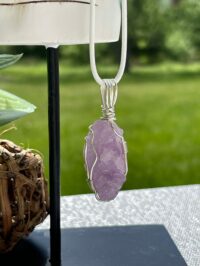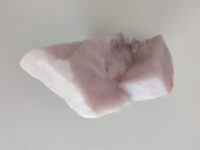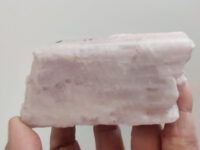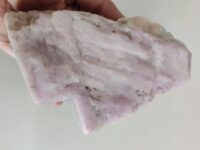- Pink Kyanite, a stunning and less common variety of kyanite, is notable for its varying shades of pink.
- Its formation process, influenced by specific environmental conditions, sets it apart from its blue and green counterparts.
- This unique gem boasts intriguing geological properties including its triclinic crystal system and variable hardness.
Before we embark on our journey, let’s talk about how kyanite got its name. Named in 1789 by Abraham Gottlieb Werner, it was christened from the Greek word “kyanos”, meaning “blue,” signifying the common color of the species. Throughout much of the 19th and early 20th centuries, mineralogists often used the French spelling, “Cyanite.” Now, let’s get back to our unique variant, the Pink Kyanite.
The Making of Pink Kyanite
The color of a gemstone isn’t just a pretty facade. It’s a story. A story of the incredible journey that began millions of years ago, deep within the Earth. Pink Kyanite’s tale begins with its main components: aluminum, silicon, and oxygen. These elements get together under extreme pressure and high temperatures, often associated with the metamorphism of clay-rich sediments.
Just like baking a cake, conditions have to be just right for our pink variety to come into existence. Trace amounts of manganese or other elements are thought to be the guest stars, contributing to Pink Kyanite’s rare and attractive color. The vibrant pink shades emerge, marking the birth of an exceptional gem.
Rocking the Geological Properties
Pink Kyanite’s physical characteristics are as fascinating as its formation. It’s part of the triclinic crystal system, meaning its crystals have three axes of unequal length intersecting at unpredictable angles. Think of a trapezoid – a shape where no two sides need to be parallel. That’s a good approximation of the triclinic structure.
Another party trick of Pink Kyanite is its variable hardness. Here’s where it gets fun: Pink Kyanite’s hardness changes depending on which direction you’re considering. It’s softer along the length (4.5 to 5.5 on the Mohs scale) and harder across the width (6 to 7 on the Mohs scale).
Pink Kyanite Meaning and Symbolism
Let’s get up close and personal with Pink Kyanite, this spellbinding gem with its rosy hue and incredible energy. Our journey isn’t just about the physical properties or formation processes; it’s about the heart and soul of this delightful gemstone.
Pink Kyanite, in its blush-toned glory, is a symbol of heart-based emotions. Think about those moments when your heart brims with feelings of love, kindness, compassion, and forgiveness. Picture the gentle flush that paints your cheeks when you’re moved by an act of selfless love or when you’re bursting with uncontainable joy. That’s Pink Kyanite for you – a representation of emotions that warm you up from the inside.
It’s not just about the giddy, cheerful moments, though. Pink Kyanite is equally about strength. Just like how it endures high pressures and temperatures beneath the earth to come into existence, it symbolizes the strength that enables us to brave through life’s challenges. Remember how it’s softer along the length and harder across the width? It’s a beautiful metaphor for resilience, reminding us that we can be flexible yet steadfast, soft yet unyielding.
Pink Kyanite carries an energy of tranquility too. Imagine a calm lake at dawn, its surface kissed by the first light of the day, radiating serene energy. Pink Kyanite is like that tranquil lake, encouraging calmness and clarity in our chaotic lives.
Finally, with its link to the heart, Pink Kyanite serves as a beacon of empathy. It’s about understanding and sharing the feelings of others. Picture the comforting sensation of being understood, of having your feelings acknowledged. That’s what Pink Kyanite embodies.
Pink Kyanite Healing Properties
Unleashing the Power of Compassion with Pink Kyanite
Remember that warm, fuzzy feeling that envelopes you when you help someone in need or express genuine kindness? Pink Kyanite is believed to help amplify those very feelings! It’s like having your personal emotional amplifier in the form of a glistening pink gemstone.
Often associated with the heart, Pink Kyanite is said to enhance compassion and encourage emotional openness. Imagine navigating your emotions with more ease and expressing your feelings more openly. Sounds freeing, doesn’t it? Whether it’s aiding in resolving emotional issues or helping you express your feelings with confidence, Pink Kyanite is a potential emotional ally in the journey of self-discovery and self-improvement.
The Spiritual Symphony of Pink Kyanite
In the hustle and bustle of daily life, moments of tranquility can be as rare and precious as a gemstone. Pink Kyanite, with its soothing blush tones, is believed to invite a sense of calmness. It’s like a gentle whisper, encouraging you to take a step back, take a deep breath, and embrace peace and serenity.
But that’s not all! Pink Kyanite is also said to enhance intuition. Imagine being able to tune into your inner wisdom more effectively, making decisions that resonate with your deepest self. Like a gentle guide, Pink Kyanite might help light the way on your spiritual journey.
Pink Kyanite Metaphysical Properties
- Pink Kyanite is believed to resonate with the heart chakra, potentially aiding in emotional balance and self-love.
- Astrologically, Pink Kyanite may have a special connection with the zodiac sign Taurus, embodying its nurturing and grounded nature.
Pink Kyanite and the Song of the Heart Chakra
Step into the world of chakras, where Pink Kyanite shines like a beacon of love and harmony. It’s believed to have a special connection with the heart chakra – the gateway of love and compassion.
Imagine strumming a guitar and having it produce the most harmonious sound. Pink Kyanite is thought to do something similar, but with the energy center of your heart. It might help to fine-tune the heart chakra, potentially enhancing your capacity for love, kindness, and compassion.
But it doesn’t stop there. This lovely gemstone is also associated with fostering self-love. Imagine cherishing your own self just as ardently as you do your loved ones. Picture being kind to yourself, accepting your flaws and celebrating your strengths. That’s the kind of self-love Pink Kyanite is said to inspire.
The Zodiac Dance – Pink Kyanite and Taurus
Let’s journey now to the celestial realm, where Pink Kyanite makes a delightful pair with Taurus, the earthy and nurturing zodiac sign.
Taurus, represented by the reliable and patient bull, is known for its grounding nature and strong desire for security. Now, imagine Pink Kyanite as a nurturing friend to Taurus, reinforcing its earthy attributes and offering emotional balance.
Picture a bull standing firmly on the ground, unshakeable, strong yet calm. That’s Taurus for you. And the Pink Kyanite? It’s like the gentle, soothing breeze that calms the bull, further stabilizing its energy.
Like a cosmic dance, Pink Kyanite and Taurus may synergize, potentially bringing stability, harmony, and an increased capacity for love and kindness.
How to Use Pink Kyanite
- Meditating with Pink Kyanite could potentially enhance emotional clarity and tranquility.
- Incorporating Pink Kyanite into your Feng Shui practice might foster a harmonious and calming atmosphere.
- Utilizing Pink Kyanite at home and work could promote a balanced, peaceful environment.
- In the realm of love and relationships, Pink Kyanite is believed to nurture compassion and open communication.
Meditative Whispers – Journeying with Pink Kyanite
Imagine starting your meditation with a piece of Pink Kyanite in your hand, its cool surface whispering stories of harmony and self-love. As you breathe in and out, envision this gemstone helping to calm your thoughts, bringing emotional clarity.
Meditating with Pink Kyanite is believed to potentially deepen the sense of tranquility and enhance the journey within. So, why not give it a try during your next meditative session?
Feng Shui – Harmonizing Spaces with Pink Kyanite
Picture Pink Kyanite as a serene guest in your home or workplace. In the world of Feng Shui, this radiant gemstone is often utilized for its potential to create harmony and promote tranquility.
Imagine placing a piece of Pink Kyanite in your living room, its soothing energy permeating the space, fostering a calm and peaceful environment. It might just be the perfect way to balance the energies of your home or workplace!
A Touch of Balance – Pink Kyanite at Home and Work
Why not invite Pink Kyanite to your everyday spaces? Its blush hues and believed calming energies could make it a welcome addition to your home or office.
Picture a piece of Pink Kyanite sitting on your office desk, it’s presence potentially aiding in maintaining a balanced, stress-free work environment. Or consider it in your living room, where it might help create a sense of harmony and peace.
Love’s Best Friend – Pink Kyanite in Relationships
Love is a dance of hearts, and Pink Kyanite is believed to be a wonderful partner in this dance. Whether you’re navigating a new relationship or strengthening a long-standing one, Pink Kyanite might just be the catalyst for nurturing compassion and enhancing communication.
Imagine presenting a piece of Pink Kyanite to your partner, symbolizing your commitment to open communication and mutual understanding. It might be a gesture that not only adds a rosy hue to your relationship but also fosters deeper emotional connection.
Pink Kyanite vs Rose Quartz
Pink Kyanite, with its ethereal blush hue and crystalline structure, is a stone that captures your attention instantaneously. Rose Quartz, on the other hand, offers a soft, delicate pink tone, known as the stone of love. So, how do these two compare?
Pink Kyanite is a rare variant of Kyanite, a silicate mineral typically found in long, blade-like crystal formations. It’s worth anywhere from $10 to $100 per carat, depending on its quality. Rose Quartz, however, is a variety of quartz with a price range of $3 to $20 per carat, determined by the depth of color and overall quality of the piece. Both are robust and durable but Pink Kyanite, with a Mohs hardness of 4.5-7 (depending on the axis), can sometimes be slightly more fragile than Rose Quartz, with a consistent hardness of 7.
With origins spanning from Brazil, USA, to Switzerland, Rose Quartz has a worldwide presence. Pink Kyanite, however, is sourced mainly from Brazil and is quite a rare find, contributing to its higher price point.
In the realm of metaphysical properties, Pink Kyanite is believed to ignite heartfelt connections and foster emotional healing. Rose Quartz, alternatively, is said to be the stone of universal love, promoting compassion, peace, and comfort.
Both are used widely in jewelry, but Pink Kyanite’s unique blade-like formations and deeper color make it a coveted stone for statement pieces. Rose Quartz’s ubiquitous presence and softer hue make it a favorite for everyday jewelry.
Pink Kyanite vs Rhodonite
Pink Kyanite and Rhodonite are two gemstones that share similar pink hues but possess quite different characteristics. Rhodonite, a manganese inosilicate, is more commonly seen in shades of pink to red and can include black veining from oxidized manganese. In contrast, Pink Kyanite is less commonly seen and can range from pale to deep pink.
Rhodonite, valued at $3 to $25 per carat, has a uniform hardness of 5.5-6.5, while Pink Kyanite’s hardness ranges from 4.5-7, depending on its crystalline axis. This difference makes Pink Kyanite a more delicate choice for jewelry, compared to the more durable Rhodonite.
Rhodonite is primarily found in Australia, Sweden, and New Jersey, USA. Pink Kyanite’s sources are fewer, found mainly in Brazil, lending it a sense of exclusivity.
Both stones carry their own legends. Pink Kyanite is said to foster emotional healing, and Rhodonite is believed to be a nurturing stone that promotes emotional balance and forgiveness. Each stone is a beloved choice for pendants, rings, and earrings, but Rhodonite is more commonly seen due to its greater availability.
Pink Kyanite vs Rhodochrosite
Rhodochrosite, like Pink Kyanite, has a beautiful range of pink hues. But unlike the latter, Rhodochrosite carries banded patterns of white or lighter pink. This manganese carbonate mineral has a Mohs hardness of 3.5-4, softer than Pink Kyanite, and should be handled with more care in jewelry.
In terms of value, Rhodochrosite ranges from $4 to $60 per carat, depending on its color and banding quality. The finest Rhodochrosite stones come from Argentina, but it’s also found in the USA, South Africa, and Romania.
Rhodochrosite is known as a stone of love and balance, believed to resonate with the heart chakra. It shares this association with Pink Kyanite, which is also connected to emotional healing and heartfelt connections.
Rhodochrosite’s banded patterns lend it a unique aesthetic for jewelry pieces, while Pink Kyanite’s longer crystal formations make it stand out in any design.
Pink Kyanite vs Morganite
Morganite, a pink to orange-pink variety of beryl, is often mistaken for Pink Kyanite due to their similar hues. Morganite typically has a higher value, ranging from $100 to $300 per carat because of its rarity and the demand in the jewelry market.
Morganite is harder than Pink Kyanite, with a Mohs hardness of 7.5-8, making it a durable choice for daily wear jewelry. Its sources span across Brazil, Afghanistan, and Madagascar.
Morganite, named after the famous financier and gem enthusiast J.P. Morgan, is believed to attract love and maintain it, whereas Pink Kyanite promotes emotional healing and heartfelt connections.
Both gemstones are popular in jewelry, especially engagement rings. Morganite’s high clarity and durability often make it a more popular choice for such important pieces.
Pink Kyanite vs Pink Tourmaline
Pink Tourmaline, also known as Rubellite, and Pink Kyanite are both coveted for their beautiful pink hues. Pink Tourmaline is a boron silicate mineral and it comes in a wider range of colors. The price of Pink Tourmaline can vary greatly from $100 to $1,000 per carat, depending on its color saturation and quality.
Pink Tourmaline has a hardness of 7-7.5, higher than Pink Kyanite. It’s found in many locations worldwide, including Brazil, Afghanistan, and the USA.
Pink Tourmaline is often associated with emotional balance and joy. Pink Kyanite, while also connected to the emotions, is more associated with healing and connection.
In terms of use, both gemstones are frequently used in jewelry. However, due to its higher hardness and brilliant color, Pink Tourmaline is often chosen for high-quality jewelry pieces including engagement rings. Pink Kyanite, on the other hand, is perfect for those looking for unique, less traditional jewelry pieces.
Pink Kyanite vs Pink Calcite
When you lay your eyes on Pink Kyanite and Pink Calcite, it’s like looking at two different sunsets. Pink Calcite, a calcium carbonate mineral, ranges from pale pink to vibrant pink, whereas Pink Kyanite varies from pale to deep pink with a crystalline structure.
Pink Calcite, priced between $2 to $20 per carat, has a Mohs hardness of 3, making it less durable than Pink Kyanite. It’s found in several locations worldwide, including Mexico, USA, and Brazil.
Pink Calcite is often referred to as the “Reiki Stone” because it’s believed to amplify energy healing. Pink Kyanite, on the other hand, is thought to foster emotional healing.
Both stones are used in jewelry, but Pink Calcite is also popular in ornamental pieces due to its beautiful pink hue.
Pink Kyanite vs Pink Opal
Pink Opal, with its opaque and often marbled pink hue, is a stark contrast to the crystalline and transparent to translucent Pink Kyanite. Pink Opal is a hydrated silica mineral and has a price range of $10 to $100 per carat, depending on its quality and origin.
With a hardness of 5.5-6.5, Pink Opal is relatively soft, making it slightly less durable than Pink Kyanite. Pink Opal is mainly found in Australia and Peru.
Pink Opal is considered a stone of peace and tranquility for the aura, while Pink Kyanite is associated with emotional healing and connection.
Both gemstones are used in jewelry, with Pink Kyanite often being favored for its unique blade-like crystal formations, while Pink Opal’s dreamy soft pink tones make it a popular choice for feminine, delicate pieces.
Pink Kyanite vs Kunzite
Kunzite, a variety of the mineral spodumene, offers a stunning array of pink tones, from subtle pastels to intense pink-violet. Its value, between $60 to $500 per carat, often reflects its perfect cleavage, making it challenging to cut without damage.
With a hardness of 6.5-7, Kunzite is somewhat more durable than Pink Kyanite. It’s primarily found in Afghanistan, Brazil, and Madagascar.
Known as the evening stone due to its light sensitivity, Kunzite is believed to help soothe emotional walls and offer release from fear. Pink Kyanite, in contrast, is associated with emotional healing and heartfelt connections.
Both gemstones are found in high-end jewelry, but Kunzite’s price and rarity often make it a more exclusive choice.
Pink Kyanite vs Pink Sapphire
Pink Sapphire, a variety of the mineral corundum, offers an intoxicating range of pink tones. It’s one of the most precious gemstones, with prices ranging from $100 to $1,000 per carat, depending on its color, clarity, and origin.
Pink Sapphire is a very hard stone, rating 9 on the Mohs hardness scale, making it much more durable than Pink Kyanite. Pink Sapphire is typically found in Madagascar, Sri Lanka, and Myanmar.
While Pink Kyanite promotes emotional healing, Pink Sapphire is often associated with passion, love, and strength.
Pink Sapphire’s high durability, intense color, and brilliance make it a favored gemstone for high-quality jewelry, including engagement rings. Pink Kyanite is typically used in less traditional, more artisanal jewelry.
Pink Kyanite vs Lepidolite
Lepidolite, a lithium-rich mica mineral, ranges in color from pink to purple, making it a lovely comparison to Pink Kyanite. Valued between $5 to $50 per carat, Lepidolite is softer with a Mohs hardness of 2.5-3.
Lepidolite is found in large quantities in Brazil, USA, and Madagascar. Known as the peace stone, it’s believed to alleviate stress and promote restful sleep.
While both stones are used in jewelry, Lepidolite’s softness makes it less suitable for everyday wear. In contrast, Pink Kyanite’s better durability and unique crystal form make it a striking choice for various jewelry designs.
Frequently Asked Questions About Pink Kyanite
What is Pink Kyanite?
Pink Kyanite is a variant of the mineral Kyanite, known for its rosy color. It’s said to have several potential emotional and spiritual benefits.
How is Pink Kyanite formed?
Pink Kyanite forms from the metamorphism of clay minerals within sedimentary and igneous rocks under high pressure and temperature conditions.
What is the hardness of Pink Kyanite on the Mohs scale?
Kyanite has variable hardness on the Mohs scale, which can range from 4.5 to 7, depending on its crystallographic direction.
Is Pink Kyanite rare?
While Kyanite itself isn’t rare, Pink Kyanite is less common than the blue variety, making it somewhat rarer and more sought after.
Does Pink Kyanite fade in sunlight?
Pink Kyanite is generally stable in light, but as with many gemstones, it’s always a good idea to avoid prolonged exposure to direct sunlight to maintain its color quality.
What chakra is Pink Kyanite associated with?
Pink Kyanite is often associated with the heart chakra, related to emotions, compassion, and love.
Does Pink Kyanite have any specific zodiac connection?
While all can benefit from Pink Kyanite, it’s often associated with the Taurus zodiac sign due to its grounding and nurturing nature.
Can Pink Kyanite be used in Feng Shui?
Yes, in Feng Shui, Pink Kyanite is often used to promote a harmonious and tranquil atmosphere.
Can Pink Kyanite be heat treated to enhance its color?
Heat treatment isn’t typically used on Kyanite as it may affect its structural stability.
What other colors does Kyanite come in?
Kyanite comes in several colors including blue (the most common), green, orange, black, and indigo, along with pink.
Is Pink Kyanite a birthstone for any month?
Pink Kyanite is not traditionally considered a birthstone for any specific month.
| Pink Kyanite Physical Properties | |
|---|---|
| Crystal Structure | Triclinic |
| Mineral Class | Silicate |
| Specific Gravity | 3.53 – 3.65 |
| Formula | Al2SiO5 |
| Hardness | 4.5 – 7 (depending on orientation) |
| Transparency | Transparent to Translucent |
| Chemical Composition | Aluminium Silicate |
| Locations | Brazil, Switzerland, Russia, USA |
| Rarity | Less common than other Kyanite variants |
| Can Be Submerged in Water | No, avoid prolonged exposure to water |
| Sun Safe Crystal | Yes, but avoid prolonged exposure to direct sunlight |
| Special Care Instructions | Clean gently with a soft cloth, avoid harsh chemicals and ultrasonic cleaners |
| Price/Carat | $5 – $50 depending on quality, size, and origin |
| Pink Kyanite Metaphysical Properties | |
|---|---|
| Chakras | Heart Chakra |
| Zodiac Signs | Taurus |
| Planets | Venus |
| Numerical Vibration | Number 7 |
| Elements | Earth |
| Symbolism | Love, Tranquility, Emotional Healing |
| Birthstones | Not traditionally a birthstone |
| Affirmations | “I open my heart to give and receive love” |
| Emotional Conditions | Anxiety, Stress, Emotional Imbalance |
| Spiritual Purposes | Meditation, Chakra Balancing, Energy Amplification |
| Crystal Combinations | Rose Quartz, Amethyst, Rhodonite for enhancing love and compassion |





